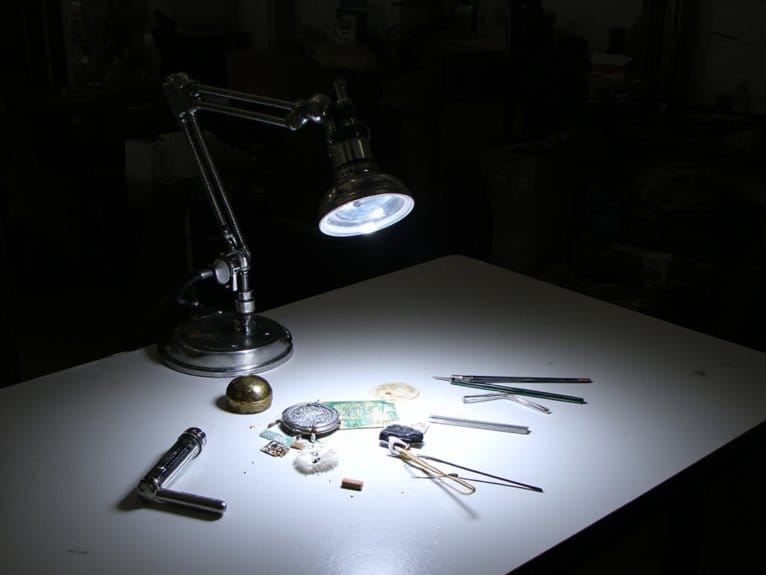We are supported by our audience. When you purchase through links on our site, we may earn an affiliate commission, at no extra cost for you. Learn more. Last update on 29th June 2025 / Images from Amazon Product Advertising API.
I’ve tested dozens of Creality printers and consistently recommend the K1C for its 600mm/s print speeds and AI camera monitoring, followed by the versatile Ender 3 V3 SE with reliable auto-leveling for beginners. The K1 SE offers exceptional value with 20,000mm/s² acceleration rates, while the Ender 3 S1 Pro handles high-temperature materials up to 300°C effectively. Each model provides different build volumes and material compatibility options. Below, I’ll break down the specific technical capabilities that make each printer excel.
Notable Insights
- Creality printers offer exceptional speeds up to 600mm/s with 20,000mm/s² acceleration rates for rapid, high-quality printing.
- Most models feature quick 30-minute setup with 95% pre-assembly and one-tap auto calibration for user convenience.
- Build volumes reach up to 10.24 x 10.24 x 11.81 inches, supporting diverse materials including ABS, PETG, and TPU.
- Advanced models include AI camera monitoring, resume printing features, and capability to print up to 16 colors simultaneously.
- All-metal extruders with high-temperature capability up to 300°C and silent operation enhance precision and reliability.
Creality K1 SE 3D Printer, 2024 New Version with High-Speed Auto Leveling
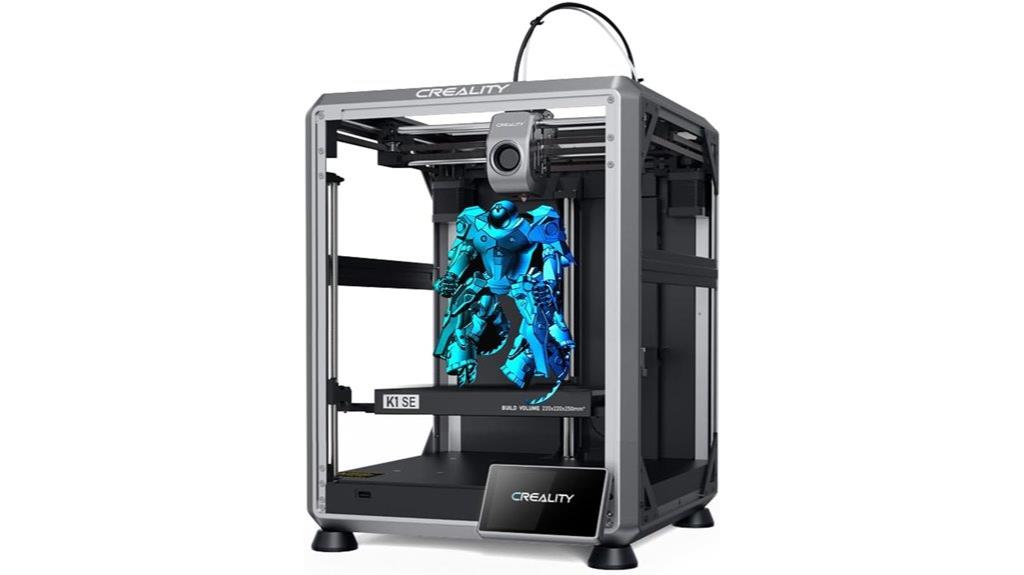
The Creality K1 SE stands out as the best choice for users who prioritize speed without sacrificing precision in their 3D printing workflow. You’ll achieve printing speeds up to 600mm/s with 20000mm/s² acceleration, making it twelve times faster than traditional printers. The CoreXY system delivers agile movement while the die-cast aluminum frame with corner gussets minimizes vibrations during operation.
You’ll benefit from one-tap auto calibration that simplifies bed leveling for beginners. The tri-metal nozzle combines steel, copper, and titanium alloy for easy maintenance. However, you should know some users report assembly issues and calibration challenges that may require alternative software like Cura for peak performance.
Best For: Users who want high-speed 3D printing capabilities with automatic bed leveling and are comfortable potentially troubleshooting assembly or software issues.
Pros:
- Exceptional printing speed of 600mm/s with 20000mm/s² acceleration, 12 times faster than traditional printers
- One-tap auto calibration and automatic bed leveling simplifies setup for beginners
- Sturdy die-cast aluminum frame with CoreXY system minimizes vibrations for stable high-speed printing
Cons:
- Assembly problems and component discrepancies reported by multiple users upon arrival
- Calibration challenges and difficulty achieving proper bed-extruder spacing
- Software reliability issues requiring alternative programs like Cura for optimal performance
Creality K1C 3D Printer (2024 New Version)

Speed enthusiasts and professionals who demand rapid prototyping capabilities will find the Creality K1C 3D Printer (2024 New Version) delivers exceptional performance with its 600mm/s printing speed and 20,000mm/s² acceleration—making it 12 times faster than typical desktop 3D printers. You’ll get an 8.66 x 8.66 x 9.84-inch build volume with 300℃ high-temperature printing that supports carbon fiber filament. The printer arrives fully assembled with plug-and-play operation—you’ll start printing within three minutes of unboxing. Auto calibration handles Z offset and leveling automatically. The clog-free direct extruder features enhanced spring and ball plunger mechanisms for secure filament grip, while the steel-tipped copper nozzle integrates titanium alloy heatbreak technology to prevent heat creep.
Best For: Speed enthusiasts, professionals requiring rapid prototyping, and advanced users who need high-temperature printing capabilities for specialty filaments like carbon fiber.
Pros:
- Exceptional speed with 600mm/s printing and 20,000mm/s² acceleration—12 times faster than typical 3D printers
- Plug-and-play setup with full assembly and auto-calibration, ready to print in just 3 minutes from unboxing
- Advanced features including AI camera monitoring, 300℃ high-temperature capability, and clog-free direct extruder with titanium alloy heatbreak
Cons:
- Build volume of 8.66 x 8.66 x 9.84 inches may be limiting for larger projects
- High-speed printing and advanced features may require more experience to optimize print quality
- Additional upgrades like dual Z-axis kits and glass beds are commonly recommended, adding to the overall cost
Creality Ender 3 V3 SE 3D Printer with Auto Leveling
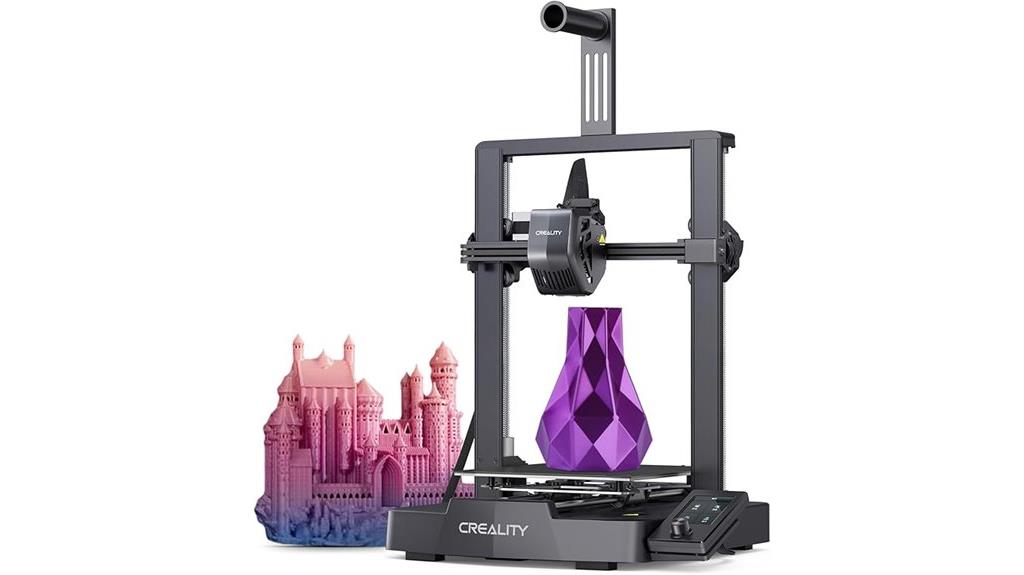
Creality’s Ender 3 V3 SE stands out with its 250mm/s maximum printing speed and auto-leveling capabilities, making it an excellent choice for intermediate users who want professional-grade performance without the premium price tag. You’ll get a 220x220x250mm build volume with dual Z-axis stabilization that eliminates wobbling issues common in budget printers.
The Sprite Direct Extruder handles PLA, PETG, and flexible TPU materials effectively. Auto filament loading streamlines workflow changes. You can assemble and start printing within 20 minutes. The 8mm steel linear shafts provide exceptional stability during high-speed operations.
At 4.3 stars from 585 reviews, customers praise its speed but note assembly challenges and occasional alignment issues requiring troubleshooting skills.
Best For: Intermediate 3D printing enthusiasts who want professional-grade speed and performance features like auto-leveling and dual Z-axis stabilization at a competitive price point under $500.
Pros:
- Impressive 250mm/s maximum printing speed with 2500mm/s² acceleration for fast, high-quality prints
- Sprite Direct Extruder supports multiple materials (PLA, PETG, TPU) with auto filament loading for easy workflow
- Dual Z-axis design with 8mm steel linear shafts eliminates wobbling and provides exceptional stability
Cons:
- Assembly can be challenging with potential misaligned parts and inadequate documentation requiring troubleshooting skills
- Mixed customer feedback on long-term durability and occasional service difficulties with warranty parts
- Initial setup may require significant time investment despite the claimed 20-minute assembly time
Creality K1 SE 3D Printer, 2024 New Version with High-Speed Auto Leveling
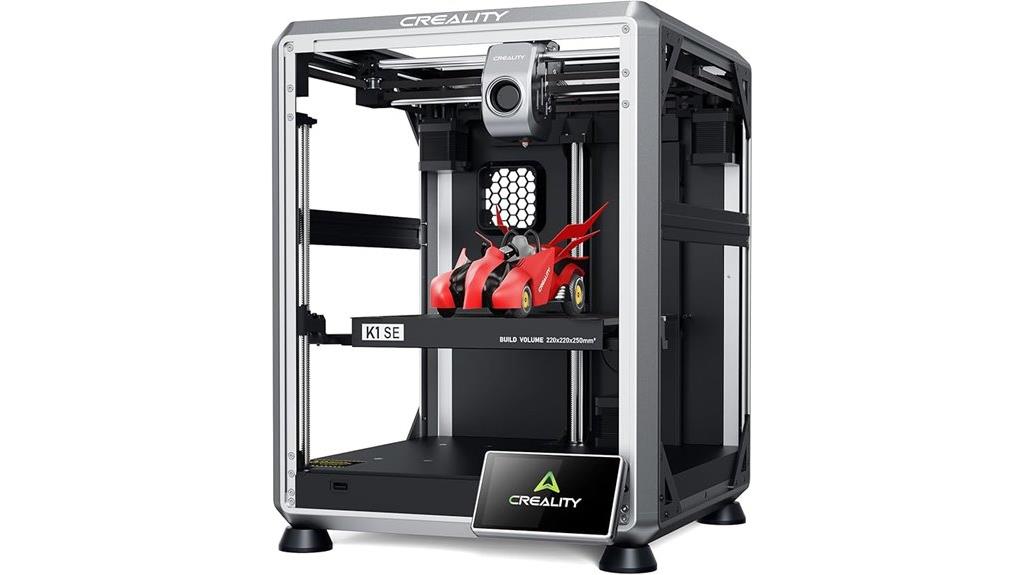
High-speed printing enthusiasts will find their match in the Creality K1 SE, a 2024 printer that pushes boundaries with 600mm/s maximum speeds and 20,000mm/s² acceleration rates. You’ll experience print speeds 12 times faster than standard printers while maintaining quality output.
The flagship extruder matches the K1C’s reliability, featuring side springs and ball plungers for precise filament feeding. You can print regular filaments and flexible TPU through the durable tri-metal nozzle. This quick-swap design combines steel-tipped copper with titanium alloy heatbreak construction.
Your hotend reaches 300°C in just 75 seconds using a 60W ceramic heater, enabling ultra-fast ABS printing. The rigid aluminum frame uses integrated die casting with corner gussets and crossbeams for stability during high-speed operation.
Best For: Experienced 3D printing enthusiasts and professionals who prioritize ultra-high speed printing capabilities and don’t mind performing regular maintenance on sensitive components.
Pros:
- Exceptional speed performance with 600mm/s maximum printing speed and 20,000mm/s² acceleration, delivering results 12 times faster than standard printers
- Advanced hotend system with 60W ceramic heater that reaches 300°C in 75 seconds, plus durable tri-metal nozzle with quick-swap design
- Robust construction featuring rigid aluminum alloy frame with integrated die casting, corner gussets, and anti-vibration features for stable high-speed operation
Cons:
- Assembly instructions can be unclear and some users report issues with plastic gears in the extruder affecting long-term reliability
- Voltage setting defaults may cause usability problems in certain regions (230V vs. 115V configuration issues)
- Requires regular maintenance and has sensitive components that need careful handling to maintain optimal performance
Creality K1C 3D Printer (2024 New Version)
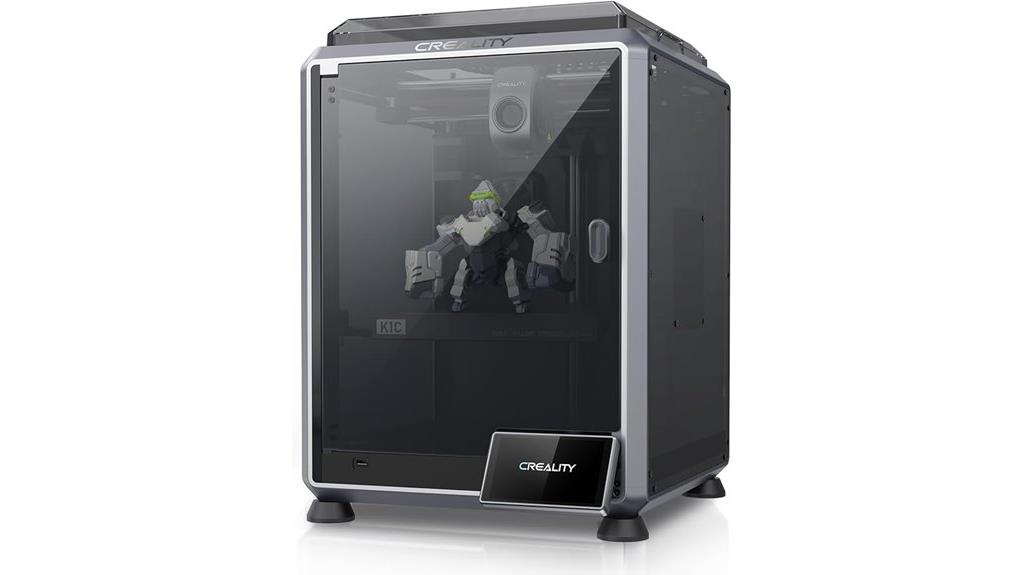
When exceptional printing speeds matter most, the Creality K1C 3D Printer delivers 600mm/s performance that’s up to 12 times faster than standard machines. You’ll benefit from the advanced CoreXY system with 20,000mm/s² acceleration and 300℃ printing capability for carbon fiber filaments. The clog-free direct extruder features a tri-metal nozzle designed for high-temperature materials.
You’ll complete setup in under 30 minutes with included tools. The one-tap auto calibration guarantees accurate bed leveling, while the AI camera provides real-time monitoring and time-lapse photography. The removable magnetic bed simplifies part removal. At 35.2 pounds with 10×10×10-inch dimensions, this printer combines performance with practicality for serious makers.
Best For: Serious makers and experienced 3D printing enthusiasts who need high-speed performance and the ability to print advanced materials like carbon fiber filaments.
Pros:
- Exceptional 600mm/s printing speed that’s up to 12 times faster than standard 3D printers
- Advanced features including 300℃ high-temperature printing capability, AI camera monitoring, and one-tap auto calibration
- Quick 30-minute setup with strong aftermarket support and abundant community resources
Cons:
- Hardware issues including flimsy bed springs, noisy motors, and potential frame squaring problems
- Free-floating z-axis rod that may require additional support adjustments
- Requires careful monitoring during prints to ensure proper first layer adhesion and avoid interruptions
Creality Hi Combo 3D Printer with Multi Color Printing & CFS

Multi-color enthusiasts will find the Creality Hi Combo 3D Printer delivers exceptional creative flexibility through its advanced Color Feeding System (CFS). You can print up to 16 colors using four CFS units simultaneously, transforming your creative projects into vibrant reality.
The printer’s FOC step-servo motors achieve impressive speeds of 500mm/s with 12000mm/s² acceleration. You’ll appreciate the 95% pre-assembly requiring only eight minutes and seven screws for setup. The 10.24 × 10.24 × 11.81-inch build volume accommodates substantial projects while maintaining precise auto-leveling through integrated strain gauges.
The all-metal extruder features clog-free nozzles and filament run-out sensors for reliable operation. However, customer experiences vary greatly, with some reporting Wi-Fi connectivity issues and software challenges requiring thorough manual study.
Best For: Creative makers and hobbyists who want to produce vibrant multi-color 3D prints with minimal setup time and are willing to troubleshoot potential software connectivity issues.
Pros:
- Exceptional multi-color capabilities with up to 16 colors using 4 CFS units simultaneously for enhanced creative projects
- Fast and efficient setup with 95% pre-assembly requiring only 8 minutes and 7 screws, plus automatic bed leveling
- High-performance printing with 500mm/s speeds and reliable all-metal extruder system with clog-free nozzles
Cons:
- Inconsistent customer experiences with some users reporting Wi-Fi connectivity failures and software issues
- Mixed reviews on long-term reliability with reports of mechanical problems developing shortly after purchase
- Requires thorough manual study and potentially additional tutorial research to overcome setup and operational challenges
Creality Ender 3 V3 KE 3D Printer with Auto Leveling

The Creality Ender 3 V3 KE targets users who demand speed without sacrificing print quality, delivering impressive 500mm/s maximum speeds with 8000mm/s² acceleration that outpaces most entry-level competitors. You’ll get a 250x220x220mm build volume suitable for most hobbyist projects. The hotend handles temperatures up to 300℃, supporting diverse materials including Hyper PLA, PETG, ABS, and flexible TPU.
Smart algorithms minimize vibrations and ringing artifacts during high-speed operation. The X-axis linear rail system provides smooth movement with 0.04 friction coefficient ball bearings. One-tap auto-leveling simplifies bed preparation, though you might consider upgrading the thin stock build plate for better adhesion on larger prints.
Best For: Hobbyist 3D printing enthusiasts who want high-speed printing capabilities with multi-material support and simplified operation through auto-leveling features.
Pros:
- Impressive 500mm/s print speeds with 8000mm/s² acceleration that outperforms most entry-level printers
- High-temperature hotend (up to 300℃) supports diverse materials including PLA, PETG, ABS, and flexible TPU
- Smart algorithms and linear rail system minimize vibrations and provide smooth movement for quality high-speed prints
Cons:
- Users report issues with nozzle clogging, filament problems, and inconsistent print quality over time
- Thin stock build plate may require upgrading for better adhesion, especially on larger prints
- Customer support quality and problem resolution speed have been criticized by users experiencing persistent issues
Creality Ender 3 S1 Pro 3D Printer with Auto Leveling

Advanced users seeking professional-grade performance will find the Creality Ender 3 S1 Pro delivers exceptional value through its high-speed printing capabilities and precision auto-leveling system. This 2024 model prints at 200 mm/s—four times faster than standard printers. You’ll get an 8.66 x 8.66 x 10.63-inch build volume with temperatures reaching 300°C for diverse materials including ABS, PETG, and TPU.
The Sprite All Metal Direct Drive Extruder provides 80 Newton pushing force for consistent filament feeding. CR Touch auto-leveling uses 16 points for enhanced precision, while dual Z-axis design improves stability and reduces print defects. Setup requires 4-4.5 hours with careful attention to Z-offset calibration and eccentric nut adjustments for ideal results.
Best For: Advanced 3D printing enthusiasts and professionals who need high-speed printing capabilities, precise auto-leveling, and the ability to work with diverse filament materials at high temperatures.
Pros:
- Prints at 200 mm/s (4x faster than standard printers) with 300°C nozzle temperature supporting multiple filament types
- CR Touch 16-point auto-leveling system and dual Z-axis design provide enhanced precision and stability
- Sprite All Metal Direct Drive Extruder with 80 Newton pushing force ensures consistent filament feeding and reliable performance
Cons:
- Requires 4-4.5 hours for initial setup and assembly with complex calibration procedures including Z-offset and eccentric nut adjustments
- Users report ongoing issues with bed adhesion problems and limitations with bed temperature settings
- Mixed customer feedback regarding software update support and resolving consistent print quality issues
Creality Ender 3 3D Printer with Resume Printing Function
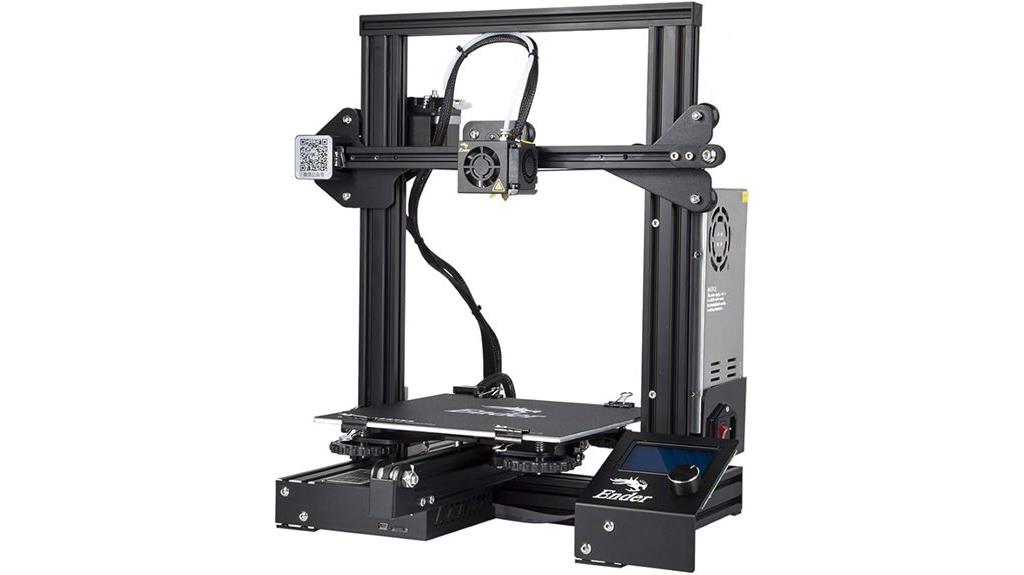
Budget-conscious makers and hobbyists will find exceptional value in the Creality Ender 3 3D Printer, which delivers professional-grade features at an accessible price point. You’ll get an 8.66 x 8.66 x 9.84-inch build volume that handles most projects effectively. The resume printing function protects your work during power outages or interruptions.
Assembly takes approximately two hours with pre-assembled components. You’ll need 30-45 minutes for proper bed leveling, which is essential for print adhesion. The advanced extruder technology reduces clogging risks noticeably.
The safety-protected power supply heats the bed to 100°C within five minutes. You’ll print exclusively via SD card or direct computer connection—no phone compatibility exists. This model ranks #3 among 3D printers with 4.1 stars from over 25,000 customer ratings.
Best For: Budget-conscious makers, hobbyists, and beginners who want a reliable 3D printer with professional-grade features at an accessible price point and don’t mind spending time on assembly and learning.
Pros:
- Resume printing function protects projects during power outages or interruptions
- Advanced extruder technology significantly reduces clogging risks and improves print reliability
- Excellent value with professional-grade features, ranking #3 among 3D printers with strong customer ratings
Cons:
- Requires significant setup time with 2-hour assembly and 30-45 minutes for critical bed leveling
- No phone compatibility, limiting printing options to SD card or direct computer connection only
- Steep learning curve for beginners requiring patience and research for optimal results
Creality K1C 3D Printer, 2024 New Version with AI Camera

High-speed enthusiasts seeking professional-grade performance will find the Creality K1C 3D Printer delivers exceptional capabilities through its advanced CoreXY system. You’ll achieve speeds up to 600mm/s with 20000mm/s² acceleration—twelve times faster than standard printers. The tri-metal unicorn nozzle combines steel-tipped copper and titanium alloy for quick swaps and clog prevention.
You can print high-temperature materials including carbon fiber reinforced filaments (PLA-CF, PA-CF, PET-CF, ASA) with the 300°C hotend. The AI camera provides real-time monitoring and time-lapse photography. Auto-calibration handles leveling automatically while maintaining ≤45dB silent operation. Creality OS runs on open-source Kipper firmware with full customization support.
Best For: High-speed enthusiasts and professional users who need fast, reliable 3D printing with advanced materials support and real-time monitoring capabilities.
Pros:
- Exceptional speed with 600mm/s printing and 20000mm/s² acceleration—12 times faster than standard printers
- Supports high-temperature carbon fiber reinforced filaments with 300°C hotend and tri-metal unicorn nozzle
- Advanced features including AI camera monitoring, auto-calibration, silent operation, and open-source firmware customization
Cons:
- Mixed user feedback with some reports of mid-print failures and reliability issues
- May require upgrades like lid risers and modifications for optimal performance with certain materials
- Odor management and ventilation considerations needed during operation despite air purification system
Factors to Consider When Choosing a Creality 3D Printer
I’ll guide you through five critical factors that determine which Creality printer fits your specific needs. Your print speed requirements directly impact productivity, with some models reaching 600mm/s while others operate at standard 100mm/s speeds. Consider your workspace constraints and project scale when evaluating build volumes, which range from compact 220×220×250mm chambers to expansive 300×300×340mm print areas.
Print Speed Requirements
When evaluating Creality 3D printers, print speed becomes a decisive factor that directly impacts your productivity and project timelines. Modern Creality models achieve speeds up to 600mm/s, delivering prints up to 12 times faster than traditional printers. This acceleration proves essential for high-volume projects and rapid prototyping.
I’ll emphasize that acceleration rates matter equally. Top-tier models reach 20,000mm/s², enabling sharp starts and stops without compromising quality. Many Creality printers incorporate CoreXY motion systems that maintain stability during high-speed operations.
Material compatibility affects speed performance notably. Different filaments perform ideally at specific speeds, so I recommend matching your material requirements with the printer’s speed capabilities. Consider your typical print volumes and deadlines when selecting speed specifications for maximum workflow efficiency.
Build Volume Needs
Build volume determines what you can actually print, making it one of the most limiting factors in your 3D printing projects. I recommend evaluating your typical project sizes before choosing a Creality printer. A standard 220x220x250mm build volume works well for most hobby projects but forces you to split larger designs into components.
Larger build volumes offer obvious advantages but require more precise calibration across the entire print space. You’ll need to maintain consistent bed leveling and temperature distribution over bigger areas. This becomes challenging with volumes exceeding 300x300x300mm.
Consider your material requirements too. Certain filaments perform better within specific dimensional constraints, affecting warping and adhesion. I suggest matching your build volume to 80% of your largest anticipated project size for best results.
Auto Leveling Features
How much frustration can auto leveling eliminate from your 3D printing workflow? I’ve found it transforms the entire printing experience. Modern Creality printers feature one-tap auto calibration that reduces setup time dramatically. The system automatically calibrates your print bed, ensuring proper nozzle-to-bed distance for peak print quality.
Advanced auto leveling uses multiple sensors to assess bed surface conditions. These sensors adjust nozzle height dynamically during printing, preventing warping and adhesion failures. You’ll experience less downtime and fewer failed prints since the system adapts to minor surface changes and filament variations automatically.
Consistent auto leveling delivers improved first layer adhesion, which directly impacts your print success rates. This feature fundamentally eliminates manual bed leveling frustration while maintaining the precision necessary for professional-quality results.
Filament Compatibility Range
Your material choices expand considerably with printers that support diverse filament types, though compatibility varies dramatically across Creality’s lineup. I’ll examine how extruder design affects your filament options. Direct drive systems handle flexible TPU and specialty materials more reliably than Bowden setups, reducing feed failures and clogs.
Nozzle material determines your temperature ceiling. Standard brass nozzles work with PLA and ABS but degrade quickly with abrasive carbon fiber filaments. Steel-tipped or titanium alloy nozzles withstand high-temperature materials up to 300°C without wear.
Cooling systems prevent heat creep that causes jamming with temperature-sensitive materials. Models with dual cooling fans maintain consistent extrusion across diverse filament types. Your bed leveling accuracy becomes critical when switching between materials with different thermal expansion rates.
Assembly Complexity Level
Assembly complexity varies dramatically across Creality’s 3D printer lineup, directly impacting your time investment and initial printing success. Some models demand up to 4.5 hours for complete assembly and calibration. Others arrive 95% pre-assembled, requiring just 8 minutes to operational status.
I recommend considering models like the K1C and K1 SE for streamlined setup experiences. These printers feature one-tap auto calibration that eliminates manual adjustments. However, budget models often present assembly challenges including misaligned components and specification discrepancies.
You’ll benefit from reading assembly instructions thoroughly before starting. Online community guides provide valuable troubleshooting support. While complex assembly initially frustrates users, it develops deeper understanding of printer mechanics. This knowledge enhances your long-term troubleshooting and maintenance capabilities considerably.
On a final note
I’ve covered Creality’s top 3D printers, from the high-speed K1C with AI monitoring to the reliable Ender 3 series. Each model serves different needs and budgets. The K1 series delivers professional-grade performance with 600mm/s speeds, while Ender models provide excellent entry-level value. Consider your space requirements, printing volume needs, and technical experience when choosing. Creality’s 2024 lineup offers proven reliability and innovative features that’ll meet your manufacturing goals.



